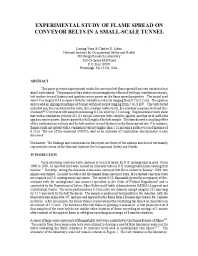Mining Publication: Experimental Study of Flame Spread on Conveyor Belts in a Small-scale Tunnel
Original creation date: February 2007
This paper presents experimental results for conveyor belt flame spread from tests conducted in a small-scale tunnel. The purpose of this study is to investigate the effects of belt type, ventilation velocity, belt surface-to-roof distance and ignition source power on the flame spread properties. The tunnel used was 4.9 m long by 0.46 m square with the ventilation velocity ranging from 0.7 to 3.2 m/s. The ignition source was an impinged methane jet burner with heat output ranging from 7 to 21 kW. The belts tested included non-fire resistant rubber belts, fire-resistant rubber belts, fire-resistant neoprene belt and fire-resistant PVC belt with belt samples measuring 0.23 m wide by 2.5 m long. Experimental results show that with a ventilation velocity of 1.02 m/s all conveyor belts could be ignited, and that with sufficient ignition source power, flames spread the full length of the belt sample. The data showed a coupling effect of the ventilation air velocity and the belt surface-to-roof distance on the flame spread rate. For instance, flames could not spread with a ventilation velocity higher than 1.52 m/s and a surface-to-roof distance of 0.22 m. The use of the measured CO/CO2 ratio as an indicator of combustion stoichiometry is also discussed.
Authors: L Yuan, CD Litton
Conference Paper - February 2007
NIOSHTIC2 Number: 20031658
Fires and Materials 2007 - 10th International Conference, January 29-31, 2007, San Francisco, California. London: Interscience Communications, 2007 Feb; :1-10
See Also
- A 20-Liter Furnace Test Method to Determine the Combustion Gas Toxicity of Conveyor Belts
- Are lithium-ion cells intrinsically safe?
- CFD Modeling of Fire Spread Along Combustibles in a Mine Entry
- Degasification System Selection for U.S. Longwall Mines Using an Expert Classification System
- Development and Application of Reservoir Models and Artificial Neural Networks for Optimizing Ventilation Air Requirements in Development Mining of Coal Seams
- Evaluation of Safety Shutoff Valve System on Methane Gas Pipelines Under Mine Fire Conditions
- Flammability of Wider Conveyor Belts Using Large-scale Fire Tests
- Impact of Air Velocity on the Detection of Fires in Conveyor Belt Haulageways
- Remote Methane Sensors
- Smoke, Carbon Monoxide, and Hydrogen Chloride Production from the Pyrolysis of Conveyor Belting and Brattice Cloth
- Page last reviewed: 4/17/2015
- Page last updated: 4/17/2015
- Content source: National Institute for Occupational Safety and Health, Mining Program


 ShareCompartir
ShareCompartir
